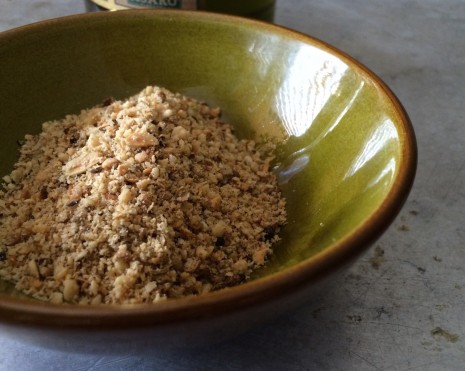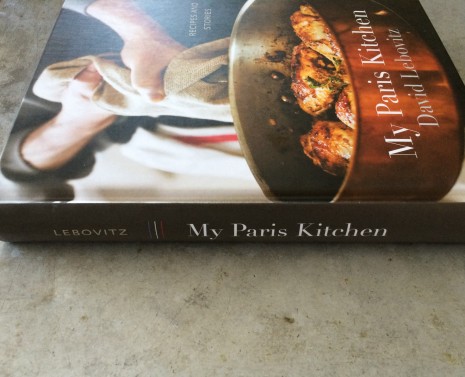DUKKAH FROM A PARIS KITCHEN
The subtitle of the recently published My Paris Kitchen: Recipes and Stories, by David Lebovitz, may lull you into putting the book on top of your bedtime-reading stack. That’s perfectly fine—it’s a terrific read—but you must be prepared to climb out of the wrapper at, say, 11 p.m. and go into the kitchen to eat something delicious. A handful of olives, say, standing in front of the refrigerator, or a smear of herbed goat cheese on toast, or even, if supper was a very long time ago, a quick scrambled egg and a glass of rosé.
But the book doesn’t just make you hungry. Lebovitz—professional cook and pastry chef (he spent almost 13 years at Chez Panisse), author of cookbooks and a memoir, and uber food blogger—has spent a decade watching how Paris has evolved in a globalized world, and his take is a savvy one. “When I moved to Paris, if someone had told me that one day there would be top-quality taquerias and burger joints here, I would have said they were fou (crazy). And some Americans can’t fathom why anyone would eat a taco or Korean bibambap in Paris, when they don’t think it’s odd to eat them in New York City or Seattle.”
Lebovitz’s recipes are an engaging, accessible mix of the traditional and international. I myself was hooked at the first chapter, on appetizers. To begin with, I’m very fond of the sort of salty and/or crisp nibblies that are delicious with drinks. More importantly, though, for home cooks everywhere, appetizers are the gateway to exotic flavors. In the United States, for instance, people who couldn’t imagine putting an entire Middle Eastern or Mexican meal on the table don’t think twice about offering hummus or guacamole to guests; store-bought versions of those once-unfamiliar foods are available at supermarkets and big-box stores (in bucket-size containers) across the country.
In the what-you-might-expect camp, Lebovitz gives us onion tart (pissaladière), eggplant caviar (caviar d’aubergines), salt cod fritters (accras de more), and, bless him, not one but three tapenades (artichoke, green olive with almonds and basil, and black olive). But interspersed among those stalwarts yet seeming perfectly at home are Indian cheese bread (naan au fromage), spiced meatballs (roulettes de merguez) with Sriracha, baba ganoush (moutabal), and the Egyptian spiced nut-and-seed condiment called dukkah.
I first had dukkah (pronounced “dook-ah” and sometimes spelled do’a, dukka, or duqqa, derived from the Arabic “to pound”) in the Middle East some years ago, and fell for it like a ton of bricks. The coarse, nubbly mixture is generally eaten on bread dipped in olive oil and served at breakfast or as an appetizer. There are innumerable versions of dukkah; according to Claudia Roden’s masterful New Book of Middle Eastern Food (Alfred A. Knopf, 2003), some people use peanuts or almonds instead of hazelnuts, or no nuts at all; others add dried mint, za’atar, or cinnamon.
I like to think this sort of thing is not such a complete stranger to the French table. Thanks to the Romans and Arabs, spices were used early on in France; a blend called épices à foison (“spices in abundance”) appears in Le Viandier de Taillevent, which dates from the 14th century and is one of the earliest recipe collections of the Middle Ages.
Even though you can buy jars of dukkah in specialty shops, nothing beats homemade, and Lebovitz’s is rich and nutty. “Each spice needs to be toasted separately,” he explains, “because the coriander seeds will take longer than the others and you don’t want to burn the spices, which can make them bitter.” Amen to that. I would also add that it’s important to let the mixture cool before grinding; otherwise, you may end up with a paste instead of a dry, loose, crumbly blend. Because my peppercorns were on the smallish side and so much harder than the other ingredients, I ground those separately so that I wouldn’t overwork everything else in the process.
And before I forget, a shopping note: Buy the hazelnuts, sesame seeds, and pumpkin seeds from a place with a high turnover, and taste them before using. If they’re rancid, take them back.
Lebovitz writes that dukkah is a great base for the world’s fastest-to-make dip, and it’s true. Mix it with good olive oil—I like to use a mild, fruity French one, such as Alziari—to make a paste and serve with slices of seeded baguette, fresh pita bread, or raw vegetables, cut into sticks, for dipping. I’ve been sprinkling the dukkah, straight, onto fried egg sandwiches, or hot buttered toast. And if you’re tempted to eat it directly out of the jar with a spoon, know that you are not alone.
Egyptian Spiced Nut Mix (Dukkah)
From My Paris Kitchen: Recipes and Stories, by David Lebovitz (Ten Speed Press, 2014)
Makes 1½ cups (150g)
½ cup (50g) hazelnuts
1/3 cup (50g) sesame seeds
¼ cup (35g) hulled pumpkin seeds
2 tablespoons whole coriander seeds
1 teaspoon cumin seeds
1 teaspoon fennel seeds
1½ teaspoons black peppercorns
1 teaspoon sea salt or kosher salt
1. Preheat the oven to 350ºF (180ºC).
2. Spread the hazelnuts on a baking sheet and toast them for 8 to 10 minutes, until the nuts are lightly browned and most of the skins are loosened. Remove from the oven. When the nuts are cool enough to handle, rub them briskly in a kitchen towel to remove as much of the skins as possible. Put the nuts into a bowl.
3. Heat a skillet on the stovetop over medium heat. Start with the sesame seeds, spreading them in an even layer in the pan and shaking or stirring them frequently, until they crackle and become lightly browned. Scrape them into the bowl with the hazelnuts. Then toast the pumpkin seeds, then the coriander, the cumin, and finally the fennel seeds in the same way, adding each to the bowl as it is done. Finally, toast the peppercorns. Most will take less than a minute. Add the salt.
4. Grind the nuts, seeds, and spices, in a mortar and pestle, with a spice grinder, or in the bowl of a mini food processor, working in batches if necessary, until the mixture is well ground together, but not too fine. Dukkah will keep for about a month stored in an airtight jar at room temperature.
Variations: Use toasted almonds, peanuts, or cashews in place of the hazelnuts. Make a quick dip by stirring together ¾ cup (75g) of dukkah with 6 tablespoons (90ml) of olive oil in a small bowl.
Posted: May 13th, 2014 under cooking, favorite books, people + places, recipes.



